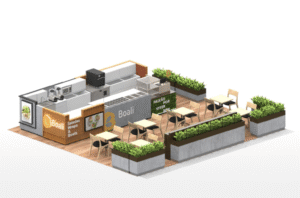
The food kiosk industry is booming, and 2025 is shaping up to be one of the best years yet to dive in. As consumers demand more convenient, fast, and high-quality food experiences, entrepreneurs are finding that a food kiosk can be the perfect low-overhead, high-return business model.
Whether you’re an aspiring foodpreneur or an established brand looking to scale, this comprehensive guide walks you through everything you need to know about launching a successful food kiosk business in 2025 — from choosing your niche to designing your store fixtures.
Why Start a Food Kiosk Business?
Food kiosks are compact, efficient, and easy to set up in malls, airports, shopping streets, theme parks, and more. They require far less capital than traditional restaurants and can yield faster profits with the right location and concept.
Key benefits include:
- Lower startup and operational costs
- Flexible business models (permanent or mobile)
- Fast return on investment
- Growing consumer demand for on-the-go dining
Step 1: Choose the Right Food Concept
The first step is selecting a profitable niche. Some trending food kiosk ideas in 2025 include:
- Bubble tea and specialty beverages
- Gourmet coffee or matcha kiosks
- Vegan and healthy snack bars
- Ethnic street food (e.g., Mexican tacos, Korean corn dogs)
- Fresh fruit juices or smoothies
- Ice cream or frozen yogurt bars
Pick a concept that matches both your passion and your market’s demand. Conduct local research to find out what’s missing in your area and what consumers are craving.
Step 2: Design a Functional and Eye-Catching Food Kiosk
Your kiosk’s look and feel plays a massive role in attracting customers. Functionality and aesthetics must go hand in hand.
A well-designed food kiosk not only reflects your brand identity but also ensures your workflow is smooth, safe, and efficient. From storage areas to customer-facing counters, every square inch should be optimized.
For premium-quality design solutions, check out food kiosk specialists who can help you with tailored structures to fit your brand’s vision and operational needs. A professional design can make your kiosk stand out in a crowded marketplace.
Step 3: Select High-Quality Store Fixtures
Your food kiosk is only as strong as the store fixtures that support it. From shelving and counters to signage and lighting, the right fixtures not only enhance your kiosk’s appearance but also improve staff productivity and customer satisfaction.
Top considerations when choosing store fixtures include:
- Durability and hygiene (especially in food environments)
- Space-saving designs
- Easy maintenance
- Customization to your brand’s layout
To explore top-notch, customizable display options, visit store fixtures experts who specialize in commercial environments like kiosks, retail shops, and more. Investing in premium fixtures ensures your business looks professional from day one.
Step 4: Find the Right Location
The success of a food kiosk depends heavily on foot traffic. Some of the best locations include:
- Shopping malls
- Airports and transit stations
- University campuses
- Business districts
- Tourist attractions
- Hospitals and large office complexes
When scouting for a location, analyze foot traffic patterns, nearby competition, rental costs, and target audience demographics.
Step 5: Understand Licensing and Permits
Operating a food kiosk requires specific licenses and permits, including:
- Business license
- Food handler certification
- Health department inspection
- Fire safety clearance
Laws vary by location, so contact your local business authority or a licensing consultant to avoid surprises.
Step 6: Build a Lean, Trained Team
Even if you’re starting small, having a reliable team is crucial. Look for staff who:
- Can multitask in tight spaces
- Handle high-volume orders quickly
- Prioritize hygiene and customer service
Train them thoroughly on food prep, customer interaction, and equipment use to ensure smooth operations.
Step 7: Leverage Technology for Smooth Operations
Integrate tech tools to streamline daily activities:
- POS systems with inventory tracking
- Contactless payment options
- Delivery app integrations
- Digital menus or self-service kiosks
Automation reduces errors, speeds up service, and improves customer experience.
Step 8: Market Your Food Kiosk
A strong marketing plan builds awareness and drives foot traffic. Use a mix of online and offline methods:
- Social media campaigns with mouth-watering visuals
- Local influencer partnerships
- Flyers and sampling at nearby events
- Google My Business listing and reviews
- Loyalty programs for repeat customers
Final Thoughts
Starting a food kiosk in 2025 is a smart business move for entrepreneurs seeking flexibility, low overhead, and high profit potential. With the right product, professional-grade store fixtures, and a strong location, you can build a thriving mini-restaurant that meets modern consumer needs.
As the market continues to evolve, stay updated with design trends, technology, and customer preferences to keep your kiosk ahead of the curve. When done right, a food kiosk isn’t just a small business — it’s a powerful brand in the making.

